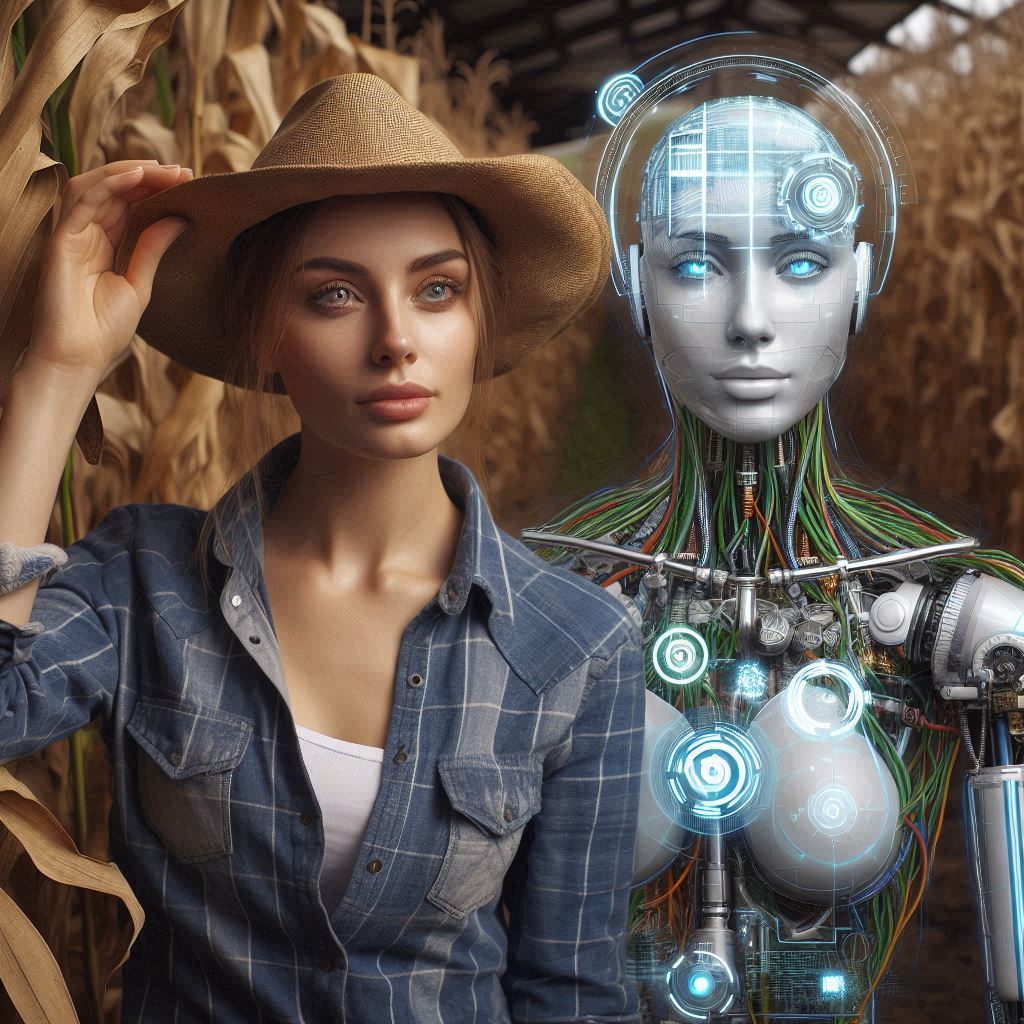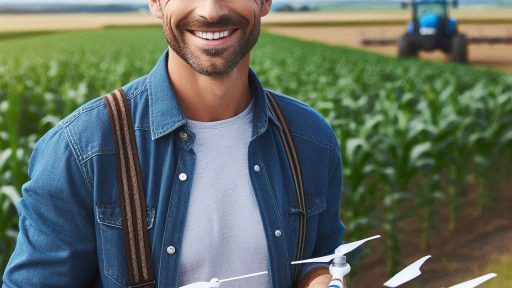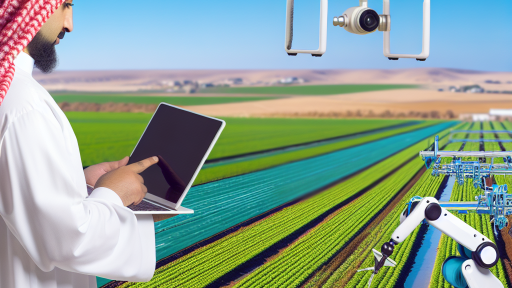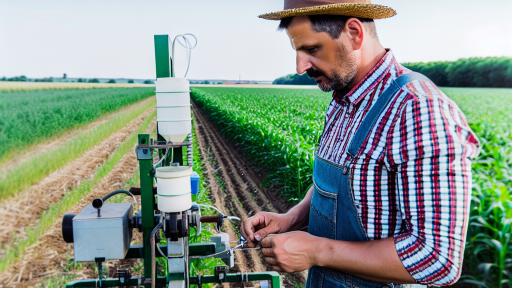Introduction
Modern farming is undergoing a tech-driven revolution.
For example, smart farming technologies can increase crop yields by 30%.
Traditional farming often struggles with inefficiency, resource wastage, and unpredictable weather.
These challenges have pushed the industry toward innovative solutions.
Revolutionary technology is now emerging as the answer.
From drones to AI-driven analytics, new tools are reshaping agriculture.
These advancements optimize resources, enhance precision, and improve productivity.
They also address critical issues like sustainability and food security.
The farming landscape is evolving rapidly, driven by these technological breakthroughs.
Key Areas of Transformation:
- Precision Agriculture: Technology allows farmers to target specific areas for treatment, reducing waste and maximizing output.
- Automation: Automated machinery and robotics reduce labor costs and improve efficiency.
- Data Analytics: Advanced data tools help farmers make informed decisions, predicting trends and optimizing crop production.
Basically, technology is not just a trend; it is transforming the farming industry.
Its potential impact on the future of agriculture is immense, promising increased efficiency, sustainability, and profitability.
The future of farming is undeniably tech-driven, and the transformation is already underway.
Precision Agriculture
Defined as the use of technology to optimize farming practices by analyzing data, Precision Agriculture aims to increase efficiency, productivity, and sustainability in the agriculture sector.
Key Principles
- Accurate data collection
- Real-time monitoring
- Precise application of resources
- Automation of farming processes
Use of GPS and IoT devices for real-time monitoring
GPS technology and IoT devices have revolutionized farming by providing real-time data on crop health, soil conditions, weather patterns, and equipment location.
Farmers can make informed decisions based on this data, resulting in improved crop yields and resource management.
Benefits
- Increased crop yields by optimizing the use of resources
- Improved resource efficiency by reducing waste
- Cost savings through optimized use of fertilizers, pesticides, and water
Case studies/examples of successful implementation
One example of successful implementation of Precision Agriculture is the use of drones equipped with sensors to monitor crop health and identify areas requiring attention.
This real-time data analysis allows farmers to take immediate action, leading to increased yields and reduced costs.
Future prospects and innovations in precision agriculture
The future of Precision Agriculture holds promising innovations such as AI-powered data analytics, autonomous farming equipment, and predictive modeling.
These advancements will further enhance efficiency, sustainability, and profitability in the agriculture sector.
Drones in Farming
Drones are revolutionizing farming by providing precise, efficient solutions to traditional agricultural challenges.
Farmers now rely on drones for various applications that enhance productivity and reduce costs.
Applications of Drones in Farming
Drones offer multiple uses in agriculture.
Farmers use drones for crop monitoring, allowing them to gather real-time data.
This data helps them detect issues such as pests, disease, and water stress.
Early detection enables timely interventions, which protect crop yields.
Spraying pesticides is another critical application.
Drones cover large areas quickly, ensuring even distribution.
This method reduces the amount of chemicals used, minimizing environmental impact.
Drones also plant seeds, especially in difficult terrains.
This technology increases planting accuracy and efficiency, leading to higher germination rates.
Advantages of Using Drones
Drones provide several advantages.
They enhance accuracy in monitoring and applying treatments, leading to better crop management.
Time efficiency is another significant benefit.
Drones perform tasks faster than manual labor, allowing farmers to focus on other important activities.
Cost reduction is a key advantage.
Drones reduce the need for large labor forces, cutting labor costs significantly.
They also minimize resource waste, saving money on seeds, water, and pesticides.
These benefits make drones an attractive investment for modern farmers.
Market Adoption and Success Stories
The adoption of drones in farming is growing steadily.
Many farmers have successfully integrated drones into their operations.
For example, vineyards use drones to monitor grape quality and ensure optimal conditions for wine production.
These success stories demonstrate the tangible benefits drones offer.
Large-scale farms also embrace drones.
They use drones for crop surveillance and precision agriculture.
These technologies help maximize yields and reduce operational costs.
As more farmers witness these benefits, drone adoption in agriculture continues to rise.
Transform Your Agribusiness
Unlock your farm's potential with expert advice tailored to your needs. Get actionable steps that drive real results.
Get StartedChallenges to Overcome
Despite the advantages, challenges remain.
Regulations surrounding drone use in agriculture vary by region.
Farmers must navigate these laws to use drones legally.
The initial cost of purchasing drones can also be a barrier.
Small farms may struggle to afford this investment.
Data management is another challenge.
Drones generate large amounts of data that require proper analysis and storage.
Farmers need the right tools and knowledge to manage this data effectively.
Overcoming these challenges is essential for the widespread adoption of drones in farming.
Future Developments and Enhancements
The future of drones in farming looks promising.
Developers are working on enhancing drone technology.
Future drones may offer even greater accuracy and efficiency.
Innovations could include drones with advanced AI capabilities for better decision-making.
As technology advances, drones will likely become more affordable, making them accessible to more farmers.
Enhanced data management tools will simplify the process of analyzing drone-collected data.
These developments will further integrate drones into farming, transforming agriculture for the better.
Read: Precision Planting: The Tech Evolution
Robotics and Automation
When we think of robotics, we often picture futuristic machines performing tasks we never imagined.
However, in agriculture, robotic technology is already transforming the industry in remarkable ways.
Existing robotic solutions for planting, harvesting, and packaging
Robots in farming are designed to perform a variety of tasks, from planting seeds and harvesting crops to packaging and sorting produce.
These machines operate with precision and efficiency, making them invaluable assets to modern farms.
Benefits: labor savings, 24/7 operations, precision.
One of the main advantages of robotic technology in farming is the significant labor savings it provides.
With robots capable of working 24/7, farmers can increase productivity and reduce the need for manual labor, ultimately cutting costs and increasing efficiency.
Additionally, robots offer a level of precision that is unmatched by human workers.
They can plant seeds at exact depths, harvest crops at the peak of ripeness, and package produce with consistent quality.
This precision not only improves the quality of the final product but also reduces waste.
Examples of farms using robotic technologies.
Many farms around the world have already adopted robotic technologies to streamline operations and increase productivity.
For example, strawberry farms in Japan utilize robots to pick and sort berries, improving efficiency and reducing labor costs.
Future trends: AI integration, new types of robots.
As technology continues to advance, we can expect to see even more advancements in the field of robotic agriculture.
One exciting trend is the integration of artificial intelligence (AI) with robotic systems, allowing machines to learn and adapt to different tasks.
In addition to AI integration, new types of robots are also being developed to tackle specific challenges in agriculture.
For example, autonomous drones are being used to monitor crops and analyze plant health, providing valuable data to farmers.
In fact, robotics and automation are revolutionizing the future of farming by providing innovative solutions to age-old problems.
With their ability to increase productivity, reduce costs, and improve efficiency, robots are poised to play a crucial role in shaping the agriculture industry for years to come.
Read: Robotics in Organic Farming: Insights

Big Data and Analytics
Big data plays a crucial role in modern farming, revolutionizing the way farmers make decisions and manage their operations.
By leveraging data from various sources, farmers can optimize resource use, improve crop management practices, and mitigate risks.
Role of Big Data in Modern Farming
Big data allows farmers to gather and analyze vast amounts of information to make informed decisions.
This data-driven approach enables farmers to enhance productivity, reduce costs, and increase efficiency.
Data Sources
- Weather Patterns: By collecting and analyzing weather data, farmers can make better decisions regarding planting, irrigation, and pest control.
- Soil Sensors: These sensors provide real-time data on soil moisture levels, temperature, and nutrient content, allowing farmers to adjust their farming practices accordingly.
- Crop Health Monitors: These devices help farmers monitor the health and growth of their crops, detect diseases or pests early, and take timely action to prevent crop loss.
Applications
- Predictive Analytics: By using historical data and machine learning algorithms, farmers can predict crop yields, market trends, and optimal planting times.
- Trend Analysis: Analyzing data trends helps farmers identify patterns, anomalies, and opportunities for improving crop yields and profitability.
- Decision Support Systems: Big data tools provide farmers with valuable insights and recommendations to make better decisions and maximize productivity.
Advantages
- Optimized Resource Use: Big data enables farmers to optimize water, fertilizer, and pesticide use, reducing waste and environmental impact.
- Improved Crop Management: Data-driven insights help farmers monitor crop health, detect problems early, and implement targeted interventions for healthier plants.
- Risk Mitigation: By analyzing data on weather patterns, market conditions, and pest outbreaks, farmers can reduce risks and losses.
Examples of Big Data Platforms and Tools
Several big data platforms and tools are transforming agriculture by providing advanced analytics capabilities and real-time insights.
Examples include:
- Climate Corporation’s Climate FieldView: This platform collects data from weather stations, drones, and sensors to help farmers make data-driven decisions.
- PrecisionHawk: A drone and data analytics company that helps farmers monitor crop health, assess field conditions, and optimize pesticide use.
- John Deere Operations Center: Offers tools for data collection, analysis, and mapping to improve farm management practices and decision-making.
Expected Advancements in Data Analytics and Machine Learning
The future of agricultural data analytics is exciting, with advancements in machine learning, artificial intelligence, and IoT technologies.
Some of the expected advancements include:
- More automated data collection and analysis processes, reducing manual effort and increasing efficiency.
- Integration of satellite imagery, drones, and IoT sensors for real-time monitoring and decision-making.
- Development of predictive models for crop yields, disease outbreaks, and market trends to aid in strategic planning.
- Enhanced predictive maintenance capabilities for farm equipment, reducing downtime and increasing productivity.
In short, big data and analytics are transforming the future of farming by providing farmers with valuable insights, improving decision-making processes, and optimizing resource management.
With continuous advancements in data analytics and machine learning technologies, the agricultural industry is poised for significant growth and innovation.
Read: Agri Drones: Beyond Just Surveillance
Biotechnology
Biotechnology in agriculture refers to the use of scientific techniques to modify or improve plants, animals, and microorganisms.
Genetic modification, CRISPR, and other biotech innovations.
Genetic modification involves the manipulation of an organism’s DNA to introduce desirable traits.
CRISPR is a powerful tool that allows for precise editing of genes.
Benefits
pest resistance, increased yield, climate resilience.
Biotechnology in agriculture offers numerous benefits, such as creating crops that are resistant to pests, have higher yields, and can withstand harsh environmental conditions.
Ethical considerations and public perception.
The use of biotechnology in farming raises ethical concerns regarding safety, biodiversity, and ownership of genetic resources.
Public perception varies, with some viewing biotech as a solution to food security issues and others expressing concerns about environmental and health risks.
Showcase Your Farming Business
Publish your professional farming services profile on our blog for a one-time fee of $200 and reach a dedicated audience of farmers and agribusiness owners.
Publish Your ProfileSuccess stories and notable biotech contributions.
Biotechnology has led to several success stories in agriculture, including the development of genetically modified crops like insect-resistant cotton and disease-resistant papayas.
Other notable contributions include the creation of drought-tolerant maize varieties and biofortified crops with enhanced nutritional value.
Future trajectories and emerging biotechnological advancements.
The future of biotechnology in agriculture is promising, with ongoing research focused on developing crops that can thrive in changing climate conditions, improving soil health, and addressing global challenges such as food security and sustainability.
Emerging advancements in biotechnology include the use of gene editing technologies like CRISPR to create crops with enhanced traits, the development of biopesticides and biofertilizers, and the exploration of synthetic biology to design novel plant varieties with specific characteristics.
Read: Harvest Tech: Robotic Arms in Use
Sustainable Farming Technologies
Importance of Sustainability in Modern Farming
Sustainability in farming ensures long-term viability and environmental balance for future generations.
Technologies Promoting Sustainability
- Hydroponics: Soilless farming method using nutrient-rich water solution.
- Aquaponics: Symbiotic system combining aquaculture and hydroponics.
- Vertical Farming: Growing crops in stacked layers or vertically inclined surfaces.
Benefits of Sustainable Farming Technologies
- Reduced land use: Vertical farming maximizes space utilization.
- Water efficiency: Hydroponics and aquaponics use 90% less water.
- Urban farming potential: Sustainable methods can be implemented in urban areas.
Case Studies Showing Effective Sustainable Practices
- Gotham Greens: Urban farming company using hydroponics on rooftops.
- BrightFarms: Hydroponic greenhouse farms providing fresh produce to supermarkets.
- Urban Organics: Aquaponics farm in Minnesota producing fish and greens sustainably.
Future Potential and Scalability of These Technologies
- Hydroponics: Scalable to meet urban food demands efficiently.
- Aquaponics: Future integration in sustainable food production systems.
- Vertical Farming: Innovations in technology for increased productivity and scalability.
All in all, sustainable farming technologies like hydroponics, aquaponics, and vertical farming play a vital role in promoting environmental conservation, efficient resource utilization, and food security.
These innovative practices not only benefit the current agricultural landscape but also offer a promising future for sustainable food production.
Blockchain in Agriculture
Blockchain is a decentralized, distributed ledger technology that ensures the secure and transparent recording of transactions.
Role in supply chain transparency, fraud prevention, and traceability.
Blockchain plays a vital role in enhancing transparency across the agricultural supply chain, preventing fraud, and ensuring traceability.
Examples of blockchain applications in food safety and quality control.
Blockchain is used to track the origin of produce, monitor its storage conditions, and verify its quality through immutable records.
Benefits
Enhanced trust, streamlined operations, improved data integrity.
Implementing blockchain in agriculture leads to increased trust among stakeholders, streamlines operations, and enhances data integrity.
Challenges and solutions in adopting blockchain in agriculture.
Challenges include high initial costs, technical expertise requirements, and interoperability issues, which can be mitigated through education and collaboration.
Future implications and widespread adoption prospects.
The future of agriculture lies in widespread blockchain adoption, promising increased efficiency, productivity, and sustainability in the industry.
Conclusion
Revolutionary technology is reshaping the future of farming.
This blog explored key advancements and their significant impacts.
Here’s a quick recap:
- Precision Agriculture: Farmers use GPS, drones, and sensors for efficient crop management and resource optimization.
- Biotechnology: Genetically modified crops improve yield, pest resistance, and drought tolerance, ensuring food security.
- Automation and Robotics: Automated machinery reduces labor costs and increases productivity, driving agricultural efficiency.
- Sustainable Practices: Eco-friendly farming techniques preserve resources and minimize environmental impact, ensuring long-term viability.
These technologies transform farming, making it more efficient, sustainable, and profitable.
The continuous evolution of agricultural practices ensures that farmers can meet global food demands.
To thrive in this changing landscape, farmers must embrace these technological advancements.
Support innovation by adopting new tools and techniques that enhance productivity and sustainability.
By staying ahead of these trends, you contribute to a more prosperous and sustainable future for agriculture.
The future of farming is bright, and technology is at the forefront of this transformation.




